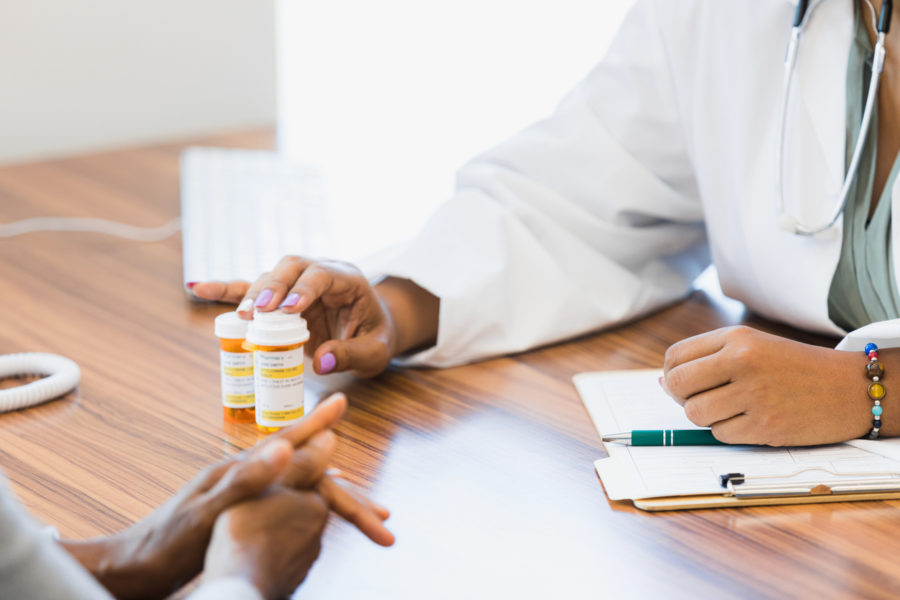Many patients are consuming five or more prescriptions each day. Think of the patients you see daily. It is likely they are at least taking one prescription ordered by you. Prepackaged medication is much more efficient than going to the pharmacy and increases patient safety as well.
You would be devastated if something were to happen to one of your patients due to a medication error, especially if you could have prevented that error.
There are several steps involved in patients obtaining medication. You must order the prescription and note the correct strength, dose and frequency. Transcription of the order takes place, usually by someone other than you like a pharmacists or pharmacy technician.
Dispensing the medication is another step that should include checking for allergies and drug interactions. Finally, administration of the medicine. This is typically done by the patient. To make sure they are taking their medicine correctly, there needs to be proper education and follow up with the patient.
At each of these stages, pharmacists are falling short, not because they intend to, but because they are overwhelmed with the thousands of orders they fill each day.
There is a way you can increase patient safety, with prepackaged medication.
Packaging and Labeling Requirements
Correct labeling is important in all medication production, especially prepackaged medication. The label, even though small, contains a large amount of information. Prepackaging facilities know just how vital this information can be for patient safety.
Controlled substances must be contained in secure packaging to avoid contamination of the medicine. Packaging much also be child-resistant to avoid any potential accidents. Controlled substances labels must be detailed and list the patient’s name, address; phone number and reason for use.
They must also list potential hazards, warnings and the prescribing doctor’s name.
Medicines are susceptible to degradation. To prevent this and any loss of potency, prepackaged medication companies do whatever they can to make sure packaging provides adequate barriers to the drugs but are also easy to use by the patient.
Companies use the best materials to protect drugs while also keeping the cost reduced. They ensure both primary and secondary packaging meets the standards set forth by governmental agencies.
This allows you to feel more confident with dispensing the medicine directly to your patients. You will be able to see first hand that the individual packages are intact, secure and tamper resistant.
Avoid Drug Interactions
Pharmacists rarely take the time to talk to patients about drug interactions. In fact, an undercover investigation by the news show 20/20 revealed that 70 percent of the pharmacies they visited did not take the time to tell patients about potentially harmful interactions.
Patients do not realize just how many dangerous drug interactions there are. They trust you and the pharmacy to give them this information. If you are relying on the pharmacist to explain interactions to your patients, you will be disappointed. Patient safety might suffer as a result.
Some of the consequences can be allergic reactions, physical and mental health issues, and even death.
Prepackaged medication comes complete with drug interaction information on the packaging. You can compare patient medications and print any interaction information from the software technology.
Educating your patients is a necessary step in helping them reach positive outcomes. If you are simply prescribing without educating, you are not fulfilling your duties completely. Patients need to know why you are prescribing medicines.
Patients will appreciate you taking the time to explain their issues and their medication to them. They will know you care about patient safety and their health.
Patient Safety is Your Safety
Medical malpractice lawsuits happen every day, even when the physician has a great reputation. There are eager people who want to file negligence claims against physicians, even when the doctor has done everything right.
If patients are given medicines that have the wrong ingredients, serious health hazards could occur. This could lead to malpractice or liability issues for your practice. The drug manufacturer could also be held responsible. Therefore many, including prepackaged companies, take extra steps to ensure the quality of their medicines.
Quality Control is Strict
Manufacturing facilities must do a lot of testing. And then they must test their testing methods. If the way they test the quality of the drugs they produce is not giving them the answers needed, they must improve it.
The building where any drug product will be held, processed or packaged endures strict scrutiny by the FDA. The size and location of the building are just as important as maintenance and operations. They are broken down for inspection purposes as internal and external environments.
The Federal Drug Administration (FDA) sets forth Current Good Manufacturing Practices (cGMPs) that all laboratories must follow to ensure safety when dealing with pharmaceuticals. These are the minimum requirements to pass inspection.
Standards such as this make prepackaged medication dispensing the best option. It ensures everything from production to dispensing is superior, putting patient safety as the highest priority.
Production of Prepackaged Medication is Safer
There are over 100 steps involved in the production of prepackaged medicines. DEA and FDA guidelines are strictly followed when creating medicines to be used by physicians who are dispensing at point of care.
This means the facility is clean, sterile and well protected. Quality management and quality assurance are top priority.
The steps taken to ensure the medicine is properly produced can seem extreme to some. However, it should also give comfort to physicians wanting to make sure the medicines they order are prepared safely and securely.
Patients are vulnerable. They trust that you are an expert with their best interest in mind. You send them to a pharmacist. Patients also must trust that the pharmacy to which you send their prescription also makes them a priority.
As you know, this is not always the case. You may have never even met the pharmacist who fills your patient’s prescription. How can you reassure your patients that they are receiving quality medicine when you know nothing about the pharmacist?
Using prepackaged medication in your own hands allows you the opportunity to provide the best service to your patients. It puts you in control of their medication and improves patient safety.




